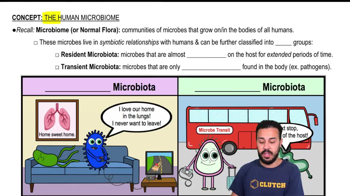Here are the essential concepts you must grasp in order to answer the question correctly.
Pathogen
A pathogen is an organism that causes disease in its host. In the context of bacteria, pathogens can invade the host's tissues, evade the immune system, and produce toxins, leading to various health issues. Understanding the role of pathogens is crucial for identifying harmful bacteria in the human body.
Recommended video:
Symbiosis
Symbiosis refers to the interaction between two different organisms living in close physical proximity, which can be beneficial, neutral, or harmful. In the case of bacteria, some can be symbiotic pathogens, meaning they can coexist with the host while also causing disease under certain conditions. This concept helps differentiate between beneficial and harmful relationships.
Gut Microbiota
Gut microbiota consists of the diverse community of microorganisms residing in the human intestine, playing a vital role in digestion, metabolism, and immune function. While many gut bacteria are beneficial or neutral, some can become pathogenic, leading to disease. Understanding gut microbiota is essential for recognizing how certain bacteria can impact human health.
Recommended video:





